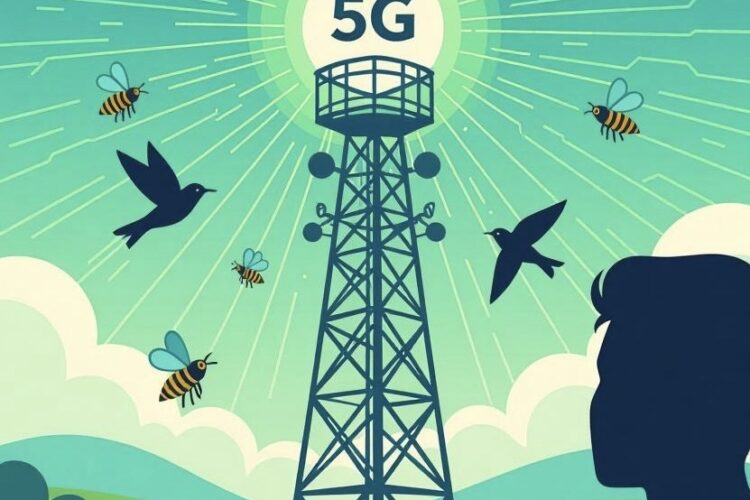5G technology, using electromagnetic radiation (EMR) and radiofrequency radiation (RFR), raises concerns about its impact on living organisms. Its millimeter waves may cause non-thermal effects like oxidative stress and DNA damage, especially in insects, where resonant effects increase RFR absorption, potentially worsening pollinator decline. Wildlife, including birds, may face disrupted magnetoreception, affecting migration and reproduction. Animal studies show fertility and nervous system issues, while human exposure links to minor symptoms like headaches, though no clear cancer risk exists below safety limits. Increased micro-cells and satellites amplify environmental pollution, risking biodiversity loss. While myths about mass die-offs lack evidence, the precautionary principle calls for more research on long-term effects. Regulatory bodies deem 5G safe, but ongoing studies are crucial to protect ecosystems.
Long Version
The rollout of 5G technology represents a major advancement in wireless communication, relying on electromagnetic radiation (EMR), electromagnetic fields (EMF), and radiofrequency radiation (RFR) to deliver faster speeds and broader connectivity. Unlike previous generations, 5G utilizes millimeter waves in higher frequency bands, introducing novel waveform characteristics and frequency-dependent effects that raise questions about potential non-thermal effects on living organisms. This non-ionizing radiation, while not powerful enough to ionize atoms, may interact with biological systems through mechanisms like resonant effects, magnetoreception disruption, and oxidative stress. As anthropogenic EMF from micro-cells deployment and low Earth orbit satellites increases, concerns about wildlife effects, insect decline, bird migration, animal health, human exposure, ecosystem impact, environmental pollution, precautionary principle adherence, and biodiversity loss have intensified. This article synthesizes peer-reviewed studies, balancing evidence of potential harms with regulatory assurances, to provide a complete resource.
Biological Mechanisms of EMF Interaction
At the cellular level, RFR from 5G can induce non-thermal effects beyond simple heating, such as alterations in voltage-gated ion channels and voltage-controlled calcium channels, which regulate cellular signaling. These changes may lead to superoxide formation and oxidative stress, where reactive oxygen species overwhelm antioxidants, causing DNA damage through strand breaks or base modifications. Studies on animals exposed to RFR frequencies similar to 5G show increased mitochondrial DNA damage in neurons, linked to elevated reactive oxygen species production. Radical pair resonance and Larmor frequency interactions could amplify these effects, particularly in far-field exposures where fields oscillate at rates disrupting geomagnetic fields or circadian rhythms. In non-mammalian models, up to 100% of studies report statistically significant oxidative stress and DNA damage, highlighting vulnerability across taxa. However, these often occur at exposure levels above ICNIRP guidelines, which focus on thermal thresholds, potentially overlooking subtler waveform characteristics.
Effects on Insects: A Critical Vulnerability
Insects, vital pollinators facing global decline, absorb RFR more efficiently at 5G’s millimeter waves due to body-size resonant effects, with power absorption rising 3-370% above 6 GHz. A 2025 systematic review of 185 studies found that EMFs negatively impact insect reproduction, development, behavior, and metabolism, often via oxidative stress and DNA damage, even at regulatory levels. For honeybees, 5G exposures disrupt life cycles, reducing pollination efficiency and contributing to pollinator decline alongside pesticides. A 2021 review positions anthropogenic EMF as a complementary driver of insect decline, with frequency-dependent effects altering voltage-gated ion channels and causing superoxide formation. Lab experiments on invertebrates reveal non-thermal effects like membrane permeability changes and circadian rhythms disruption, though field studies remain limited. Critics note that while pollinator decline is multifactorial, increasing micro-cells deployment exacerbates far-field exposures, potentially accelerating biodiversity loss.
Impacts on Wildlife: From Birds to Broader Fauna
Wildlife effects are pronounced in species reliant on magnetoreception, such as migratory birds, where oscillating EMFs from 5G interfere with geomagnetic fields, disrupting orientation and navigation. A 2023 analysis links millimeter waves to reduced reproductive success in birds, affecting mating behaviors and physiological functions via radical pair resonance. Bird migration patterns show disorientation from low-level RFR, with studies indicating ecosystem impact through altered survivorship and biodiversity loss. Bats may experience echolocation impairment from waveform characteristics, while amphibians and other fauna exhibit oxidative stress and DNA damage. A 2022 review of over 1,200 studies across taxa found significant effects in 593 cases, including non-thermal disruptions from increasing anthropogenic EMF. Low Earth orbit satellites add to this by elevating background RFR, potentially harming nocturnal species through circadian rhythms disruption.
Animal Health: Laboratory Insights and Real-World Implications
In controlled settings, animals exposed to RFR display animal health issues like fertility reductions and nervous system alterations, driven by oxidative stress and DNA damage in reproductive cells. Rodent studies reveal mitochondrial DNA damage in neurons from 1.8 GHz fields, with similar risks at 5G frequencies. Frequency-dependent effects on voltage-controlled calcium channels may explain behavioral changes, while Larmor frequency interactions contribute to superoxide formation. However, many findings stem from exposures exceeding typical 5G levels, and regulatory bodies like WHO argue no conclusive harm below guidelines.
Human Exposure: Weighing Risks and Evidence
Human exposure to 5G raises concerns about oxidative stress, altered gene expression, and potential carcinogenicity, with some studies linking FR1 frequencies (450-6000 MHz) to gliomas. A 2021 pragmatic review found no confirmed hazards above 6 GHz at low levels, but calls for more research on skin effects and immune function. Symptoms like headaches and sleep disturbances correlate with higher RFR in some populations, potentially via non-thermal effects. ICNIRP and WHO guidelines deem exposures safe, with no causal links to cancer or other diseases from 2G-5G networks.
Ecosystem Impact and Broader Environmental Concerns
The proliferation of micro-cells deployment and low Earth orbit satellites amplifies anthropogenic EMF, contributing to environmental pollution and potential biosphere-level damage. This could exacerbate biodiversity loss by affecting pollinator decline, bird migration, and overall ecosystem impact through disrupted geomagnetic fields and oxidative stress across species. Satellite mega-constellations introduce additional RFR, with light pollution and radiation potentially harming nocturnal wildlife.
Debunking Myths and the Precautionary Principle
Viral claims that 5G causes mass die-offs or pandemics lack evidence, often conflating unrelated events. WHO and ICNIRP affirm no adverse health effects below limits, debunking radiation myths as non-carcinogenic at typical exposures. Yet, the precautionary principle urges more research on long-term, low-level effects, especially with 5G’s rapid expansion.
In conclusion, while evidence suggests potential risks from 5G’s EMR on insects, wildlife, animals, and humans through mechanisms like oxidative stress and magnetoreception disruption, real-world harms remain unproven below guidelines. Balanced monitoring and interdisciplinary studies are essential to safeguard ecosystems amid advancing technology.
Hashtags For Social Media
#5G #5GHealthRisks #5GEffects #InsectDecline #PollinatorDecline #SaveTheBees #WildlifeImpact #BirdMigration #AnimalHealth #HumanExposure #EMFRadiation #RadiofrequencyRadiation #NonIonizingRadiation #OxidativeStress #DNADamage #Magnetoreception #MillimeterWaves #ResonantEffects #EcosystemImpact #BiodiversityLoss #EnvironmentalPollution #PrecautionaryPrinciple #AnthropogenicEMF #MicroCellsDeployment #LowEarthOrbitSatellites #5GMyths #5GFacts #WakeUpTo5G #RadiationAwareness #EcoTechImpact
Related Questions, Words, Phrases
does 5g affect insects | is 5g dangerous for wildlife | 5g radiation effects on human health | how does 5g impact living organisms | are bees harmed by 5g towers | 5g and insect population decline | wildlife risks from 5g networks | human health concerns with 5g exposure | 5g emf effects on animals | is 5g causing bird migration issues | pollinator decline linked to 5g | 5g millimeter waves and dna damage | environmental impact of 5g on ecosystems | does 5g cause oxidative stress in cells | 5g safety for insects and bugs | wildlife health problems from radiofrequency radiation | human symptoms from 5g radiation | 5g effects on magnetoreception in animals | is 5g technology harming pollinators | biodiversity loss due to 5g deployment | 5g non-thermal effects on living things | risks of 5g to migratory birds | insect absorption of 5g waves | 5g and animal fertility issues | human cancer risks from 5g | ecosystem disruption by 5g emr | does 5g interfere with geomagnetic fields | 5g impact on nocturnal wildlife | precautionary principle for 5g health risks | 5g myths vs facts on wildlife harm | long-term effects of 5g on human immune system | 5g radiation and superoxide formation in cells | is 5g accelerating insect decline | wildlife exposure to 5g micro-cells | human headaches from 5g networks






